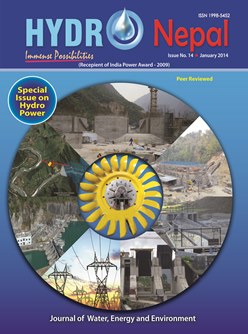Regional Modeling for Estimation of Runoff from Ungauged Catchments: Case Study of the Saptakoshi Basin, Nepal
DOI:
https://doi.org/10.3126/hn.v14i0.11269Keywords:
Regional modeling, ENKI, Ungauged catchments, Saptakoshi Basin, NepalAbstract
In a mountainous country like Nepal, most of the gauge stations are located at low altitudes, and getting reliable hydrological data at intake sites, most of which are located at high mountains, is difficult. The main objective of the study is to apply the ENKI model system in a regional calibration of the Saptakoshi Basin and to test the reliability of the model in this area and extract the runoff at ungauged sites. ENKI is a modular framework to implement hydrological models, which operates on distributed data within a spatial region. Models can be created by a set of user-defined subroutines to custom design the functionality, and the model can be calibrated in a region making it suitable for prediction in ungauged catchments. Climatic data from 1999 to 2008 are used for the model calibration in the Saptakoshi Basin. While processing data, some errors and inconsistencies in the flow data were found, and this reduced the potential calibration sites in the catchment. The results showed that the modeled discharge of independent and upstream catchments were well in agreement with observed data, while less agreement was found with downstream basins where observed data were inconsistent. Good quality observation data and the availabilityof enough data govern the quality of the simulation with the model, so the importance of data quality cannot bedisregarded. Finally, the obtained regional parameters were applied to extract the runoff data at the intake site of the Tamor hydropower plant. Further improvement of simulation results can be achieved with good quality of data and thus uncertainties in the parameters can be reduced. Even though there are some uncertainties in the results of model, the conclusion of this study is that the regional model, ENKI, could be a very helpful tool to predict the hydrological variables at the ungauged basins in a mountainous country like Nepal.
DOI: http://dx.doi.org/10.3126/hn.v14i0.11269
HYDRO Nepal Journal
Journal of Water, Energy and Environment
Volume: 14, 2014 January
Page: 61-72
Downloads
Downloads
Published
How to Cite
Issue
Section
License
The copyright of the articles and papers published is held by HYDRO Nepal Journal.
The views and interpretation in this journal are those of author(s), and HYDRO Nepal does not bear any responsibility for the views expressed by authors in the journal.




